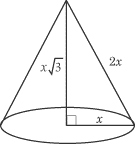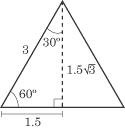Cones
A cone is not a prism, but it is similar to a cylinder. A cone is
essentially a cylinder in which one of the bases is collapsed into a single
point at the center of the base.

The radius of a cone is the radius of its one circular base. The height of a
cone is the distance from the center of the base to the apex (the point on top).
The lateral height, or slant height, of a cone is the distance from a point on
the edge of the base to the apex. In the figure above, these three measurements
are denoted by r,h, and l, respectively.
Notice that the height, radius, and lateral height of a cone form a right
triangle. This means that if you know the value for any two of these
measurements, you will always be able to find the third by using the Pythagorean
theorem.
Volume of a Cone
Since a cone is similar to a cylinder except that it is collapsed to a single
point at one end, the formula for the volume of a cone is a fraction of the
formula for the volume of a cylinder:
Volume of cone = 1/3 Volume of a cylinder
= 1/3 pr
2h
where
r is the radius and
h is the height.
For practice, find the volume of the cone pictured below:

To answer this question, just use the formula for the volume of a cone with the
following values plugged in: r = x,
l< = 2x, and h = xv3.
The volume is:

Surface Area of a Cone
The surface area of a cone consists of the lateral surface area and the area of
the base. Because the base is a circle, it has an area of pr2.
The lateral surface is the cone “unrolled,” which, depending on the shape of the
cone, can be the shape of a triangle with a curved base, a half-circle, or a
“Pacman” shape. The area of the lateral surface is related to the circumference
of the circle times the lateral height, l. This is the formula:
Lateral surface area of cone = p
rl
where
r is the radius and
l is the lateral height.
The total surface area is the sum of the base area and lateral surface area:
Total surface area of cone = p
r2 + p
rl
When you are finding the surface area of a cone, be careful not to find only the
lateral surface area and then stop. Students often forget the step of adding on
the area of the circular base. Practice by finding the total surface area of the
cone pictured below:

The total surface area is equal to the area of the base plus the area of the
lateral surface. The area of the base = px2. The lateral
surface area = px × 2 x. The total surface area therefore
equals px2 + p2x2 = 3px2.
Pyramids
A pyramid is like a cone, except that it has a polygon for a base. Though
pyramids are not tested very often on the Math IC test, you should be able to
recognize them and calculate their volume.

The shaded area in the figure above is the base, and the height is the
perpendicular distance from the apex of the pyramid to its base.
Volume of a Pyramid
The formula for calculating the volume of a pyramid is:
Volume = 1/3 B
h
where B is the area of the base and h is the height. Try to find the
volume of the pyramid below:

The base is just a square with a side of 3,and the height is 3v2/2.
B = 32 = 9, and the total
volume of the pyramid is:
.gif)
Surface Area of a Pyramid
The surface area of a pyramid is rarely tested on the Math IC test. If you come
across one of those rare questions that covers the topic, you can calculate the
area of each face individually using techniques from plane geometry, since the
base of a pyramid is a square and the sides are triangles. Practice by finding
the surface area of the same pyramid in the figure below:

To calculate the surface area, you need to add together the area of the base and
the areas of the four sides. The base is simply a square, and we’ve seen that
B = 32 = 9. Each side is
an equilateral triangle, and we can use the properties of a 30-60-90 triangle to
find their areas:

For each triangle, Area = 1 /2 × 3 ×3 v3/2=
9 v3/4. The sum of the areas of the four triangles is 4
×9 v3/4= 9 v3
The total surface area of the pyramid is 9 + 9 v3
Spheres
A sphere is the collection of points in three-dimensional space that are
equidistant from a fixed point, the center of the sphere. Essentially, a sphere
is a 3-D circle. The main measurement of a sphere is its radius,
r, the distance from the center to
any point on the sphere.

If you know the radius of a sphere you can find both its volume and surface
area. The equation for the volume of a sphere is:
Volume of a sphere = 4/3 pr
3
The equation for the surface area of a sphere is:
Surface area of a sphere = 4surface area of a sphere
r2
Back
Next
Next to display next topic in the chapter.
Mathematics Practice Questions
Video Lessons and 10 Fully Explained Grand Tests
Large number of solved practice MCQ with explanations. Video Lessons and 10 Fully explained Grand/Full Tests.